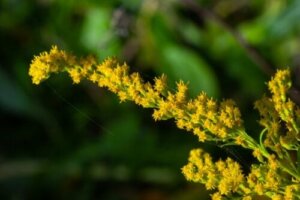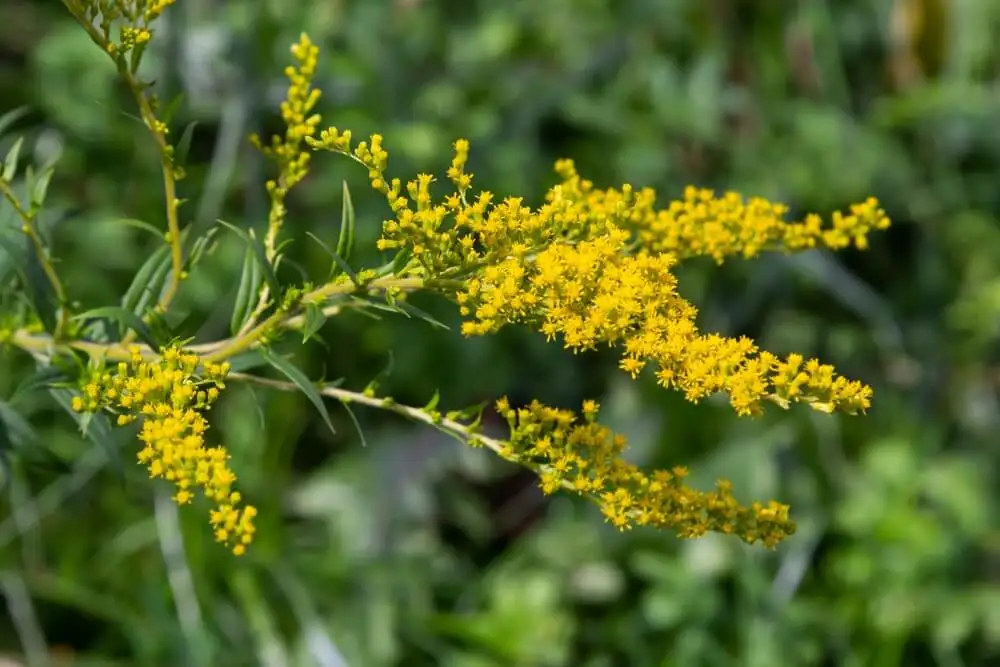Goldenrod: Medicinal Applications and Contraindications


Reviewed and approved by the pharmacist Franciele Rohor de Souza
Goldenrod, also called Solidago canadensis or Solidago virgaurea, is a perennial herbaceous plant found throughout the Iberian Peninsula and North America. It belongs to the Asteraceae family and attracts attention due to its intense yellow buds, from which it gets its name.
Due to its pharmacological composition, which includes flavonoids, tannins, saponins, and organic acids, it’s regularly used in the manufacture of herbal supplements. Some people even prepare it as an infusion to soothe some symptoms and ailments. What are its main applications and contraindications? Discover them here!
Composition and properties of goldenrod
The wide variety of benefits of goldenrod is attributed to its abundant content in various phytochemicals. In particular, and as compiled by a review shared in the journal Biomolecules, the plant contains the following substances:
- Flavonoids (mainly quercetin and kaempferol derivatives).
- C6-C3 polyphenolic acids (caffeic, chlorogenic, ferulic, sinapic, 3-hydroxyphenyl acetic, 3,4-dihydroxyphenylacetic, homovanillic acids).
- Glycoside compounds.
- Essential oils containing monoterpenes (alpha- and beta-pinene, myrcene, limonene, sabinene).
- Saponin molecules (such as virgaureasaponins and solidagosaponins).
These compounds are associated with a number of health effects and properties. Specifically, it has been observed that they have anti-inflammatory, antioxidant, analgesic, spasmolytic, antihypertensive, diuretic, antibacterial, and cardioprotective potential. Let’s take a look at its main medicinal uses.
Find out more: 7 Adaptogenic Plants to Combat Stress
Medicinal applications of goldenrod
In traditional medicine, goldenrod has been used as a diuretic and adjuvant for urological conditions. Its use is also linked to the prevention of infections and the relief of muscular ailments. But is there any evidence? Keep reading!

Natural diuretic
Goldenrod is classified as a “natural diuretic”. Diuretics are substances that stimulate the production of urine to facilitate the elimination of retained fluids in the body. They thus support the treatment of edematous conditions, high blood pressure, and kidney problems.
A European Medicines Agency publication highlights the potential of goldenrod as an adjuvant to increase the amount of urine and reduce the discomfort caused by minor urinary disorders.
This is largely explained by its content of saponins, substances that increase blood circulation at the renal level, which increases glomerular filtration and, therefore, the expulsion of liquids.
However, more extensive and conclusive studies are required to evaluate this effect in humans, as most of the tests have been carried out on animals.
Urinary tract conditions
In popular tradition, goldenrod is used as an adjunct to promote the relief of urinary tract conditions. As compiled in a publication in Western New York Urology Associates, it’s often used for bladder infections, urinary tract irritation, and kidney stones.
Due to its diuretic properties, the plant is associated with increased urine flow, decreased tissue inflammation, and the control of spasms in the urinary tract. However, there’s no conclusive evidence in this regard.
As in the previous case, the studies have been carried out mainly on animals. Because of this, the evidence is considered insufficient to support its use in these conditions. In fact, it’s recommended to avoid it as a first-choice treatment.
Urinary conditions tend to become complicated without medical treatment. Therefore, the priority is to go to a doctor and follow their recommendations.
Anti-inflammatory and antispasmodic
The anti-inflammatory and antispasmodic properties attributed to goldenrod are often used as an adjuvant for muscle pain, arthritis symptoms, and asthma, among other conditions. However, there’s insufficient evidence.
For now, studies on animals suggest that substances such as triterpene saponins, polyphenols and tannins are behind these effects. However, it hasn’t been proven to be an effective and safe treatment.
Other possible uses of goldenrod
Most medicinal applications of goldenrod are supported only by anecdotal evidence. Cautious use is recommended, especially if there are prior diagnosed illnesses or any special conditions.
According to a publication by the US corporation WebMD, other uses – not supported with evidence – are as follows:
- Diabetes
- Hemorrhoids
- Arthritis and gout
- Inflamed mouth
- Eczema (topical use)
- Liver enlargement
- Minor wounds (topical use)
- Respiratory infections (such as cases of flu and colds)

Risks and contraindications of goldenrod
At present, there isn’t enough reliable information to state that goldenrod and derived supplements are safe. However, the side effects that have been described are mild; these include abdominal pain, heartburn, cramps, and nausea.
Some people may experience allergic reactions to this plant’s consumption or topical application. If so, clinical manifestations include swelling of the tongue and mouth, skin irritation, and respiratory difficulties.
It is necessary to seek urgent medical assistance in these cases.
For safety, the plant is contraindicated in the following scenarios:
- Heart and kidney diseases
- Pregnancy and lactation
- Young children
- Osteoporosis
- Diabetes
On the other hand, it shouldn’t be consumed simultaneously with diuretic, high blood pressure, or diabetes medications. This is because it can excessively potentiate its effect, which would put health at risk.
Dosage and presentations of goldenrod
Before taking goldenrod supplements – or supplements of any other herb – it’s advisable to consult a doctor to determine if there are any risks associated with its consumption. The plant is available in dried form, in tea bags, extracts, tinctures, and capsules.
- Infusion: 3 to 5 grams of the plant in boiling water, 2 or 3 times a day.
- Liquid extract or tincture: 0.5 to 2 milliliters, 2 or 3 times a day.
- Dry extract: 350 to 450 milligrams, 3 times a day.
- Macerated: 40 grams of the dry plant are soaked in 1 liter of cold water. After 12 hours, the liquid is applied topically with compresses.
Read also: Bacopa, a Plant that Can Benefit Your Memory
What to remember about this plant?
Goldenrod is an herbal supplement valued in traditional medicine for its diuretic, anti-inflammatory, antibacterial, and antioxidant properties. It has a long history as a remedy for some urinary tract conditions. However, its efficacy isn’t proven by science.
To date, few animal and laboratory studies have been able to evaluate the potential of this plant as a health ally. Therefore, it shouldn’t replace medical treatments for these conditions. For safe use, it’s recommended to follow the recommendations of the practitioner and the supplement manufacturer.
All cited sources were thoroughly reviewed by our team to ensure their quality, reliability, currency, and validity. The bibliography of this article was considered reliable and of academic or scientific accuracy.
- Fursenco C, Calalb T, Uncu L, Dinu M, Ancuceanu R. Solidago virgaurea L.: A Review of Its Ethnomedicinal Uses, Phytochemistry, and Pharmacological Activities. Biomolecules. 2020 Nov 30;10(12):1619. doi: 10.3390/biom10121619. PMID: 33266185; PMCID: PMC7761148.
- Arumugham VB, Shahin MH. Therapeutic Uses Of Diuretic Agents. [Updated 2022 Jun 5]. In: StatPearls [Internet]. Treasure Island (FL): StatPearls Publishing; 2022 Jan-. Available from: https://www.ncbi.nlm.nih.gov/books/NBK557838/
- European Medicines Agency. Committee on Herbal Medicinal Products: Community Herbal Monograph On Solidago virgaureaL., Herba. Evaluation of Medicines for Human Use. 2008;2-5.
- European Medicines Agency. Assessment Report On Solidago virgaurea L., Herba. Evaluation of Medicines for Human Use. 2008;2-31
- Melzig MF. Echtes Goldrutenkraut–ein Klassiker in der urologischen Phytotherapie [Goldenrod–a classical exponent in the urological phytotherapy]. Wien Med Wochenschr. 2004 Nov;154(21-22):523-7. German. doi: 10.1007/s10354-004-0118-4. PMID: 15638071.
- Goldenrod. (2014). Western New York Urology Associates, LLC. Available in https://www.wnyurology.com/content.aspx?chunkiid=21754#ref2
- Sampson JH, Phillipson JD, Bowery NG, O’Neill MJ, Houston JG, Lewis JA. Ethnomedicinally selected plants as sources of potential analgesic compounds: indication of in vitro biological activity in receptor binding assays. Phytother Res. 2000 Feb;14(1):24-9. doi: 10.1002/(sici)1099-1573(200002)14:1<24::aid-ptr537>3.0.co;2-9. PMID: 10641043.
- Weishaupt, J., (2021). Are There Health Benefits of Goldenrod? Disponible en:https://www.webmd.com/vitamins-and-supplements/health-benefits-of-goldenrod
- Luengo, M., (2001). Saponósidos. Disponible en https://www.elsevier.es/es-revista-offarm-4-articulo-saponosidos-13015492#:~:text=Los%20sapon%C3%B3sidos%20tienen%20la%20capacidad,se%20da%20un%20efecto%20diur%C3%A9tico.&text=Algunos%20sapon%C3%B3sidos%20presentan%20este%20efecto%20(p.
This text is provided for informational purposes only and does not replace consultation with a professional. If in doubt, consult your specialist.








